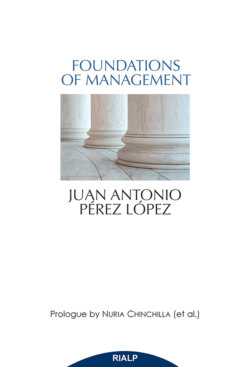Читать книгу Foundations of management - Juan Antonio Pérez López - Страница 3
ОглавлениеFIRST PART THE COMPANY: A HUMAN ORGANIZATION
CHAPTER 1: BUSINESS ORGANIZATIONS AS HUMAN REALITIES
Introduction
Formal organization and real organization
Elements of the formal organization
Elements of the real organization
Theories or models for explaining organizations
Mechanical or technical system models
Organic models: the organization as an organism
Anthropological model: the organization as an institution
Application of models to real-life situations
The business firm as a human reality
CHAPTER 2: HUMAN MOTIVATION – Mechanistic and psycho-sociological theories
Introduction
The psycho-sociological models
McGregor: Theory X and Theory Y
The limits of the psycho-sociological paradigm
CHAPTER 3: THE ANTHROPOLOGICAL THEORY OF MOTIVATION
Introduction
Motivational conflicts and their relationship to learning
CHAPTER 4: THE INFORMAL OR SPONTANEOUS SYSTEM
Introduction
The formal system of an organization
The spontaneous or informal system of an organization
The operative and structural relationship of an organization
CHAPTER 5: HOW ORGANIZATIONS WORK (I) – I. The mechanistic models
Introduction
The concept of “organizational purpose” in mechanistic model
The nature of the “fund of incentives”
The intrinsic limits of “coercive power”
The extrinsic limits of “coercive power”
CHAPTER 6: HOW ORGANIZATIONS WORK (II) – II. The psycho-sociological models
Introduction
The psycho-sociological models
The psycho-sociological notion of “organizational purpose”
CHAPTER 7: HOW ORGANIZATIONS WORK (III) – III. The anthropological models
Introduction
The concept of the organization’s unity
The business organization as an institution
SECOND PART: GOVERNANCE DECISIONS
CHAPTER 8: THE FUNCTIONS OF MANAGEMENT
Introduction
The content of management processess
The models or paradigms of management
The strategic dimension of management
The executive dimension of management
The leadership dimension of management
CHAPTER 9: EVALUATION OF MANAGEMENT DECISIONS (I) – I. The effectiveness criterion
Introduction
The effectiveness criterion in management decisions
CHAPTER 10: EVALUATION OF MANAGEMENT DECISIONS (II) – II. The efficiency criterion
The efficiency criterion in management decisions
CHAPTER 11: EVALUATION OF MANAGEMENT DECISIONS (III) – III. The consistency criterion
The consistency criterion in management decisions
Extrinsic, intrinsic and transcendent motives in decisions
Affective satisfaction: sentiments and emotions
CHAPTER 12: ETHICS AND MANAGEMENT – The application of the consistency criterion
Introduction
The contents of “business ethics”
Personal and professional ethics of the manager
CHAPTER 13: FORMULATION OF THE FIRM’S PURPOSE
Introduction
Subjective and objective ends of a decisions-maker
Subjective and objective ends of business organizations
The formulation of purpose in business organizations
CHAPTER 14: OPERATIONAL DEFINITION OF THE PURPOSE
Introduction
Validity and operationality of the definition of a purpose
Operational definition of a goal
Operational definition of an object
Operational definition of the mission
The generic and specific mission of an organization
CHAPTER 15: THE DESIGN OF THE ORGANIZATION
Introduction
Operational definition of purposes in business organizations
Design of a business organization
CHAPTER 16: STRUCTURING THE DESIGN
Introduction
CHAPTER 17: IMPLEMENTING THE PURPOSE
Introduction
